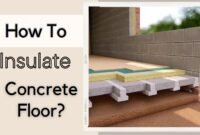Homeowners often choose to insulate their garage ceilings with foam board and rigid insulation to safeguard against moisture and seepage. This insulation is particularly useful for garages used as living spaces or those with a room above, as it helps maintain a comfortable temperature and reduces the need for excessive heating or cooling.
Foam board insulation is particularly effective for existing concrete block structures, providing a barrier against external elements.
When insulating your garage, it’s crucial to ensure the interior stays warm and protected from cold air. While foam board insulation is a popular choice, exploring other materials like spray foam and cellulose insulation can offer additional benefits.
This is especially true for garages that serve as living spaces or have rooms above, where temperature consistency is key. Each type of insulation offers unique advantages, particularly for specific areas such as the room above the garage.
In-Depth Knowledge and Insights
Benefits of Foam Board Insulation
- Thermal Resistance: Foam board insulation provides excellent thermal resistance, ideal for maintaining stable temperatures.
- Moisture Barrier: It acts as a barrier against moisture, protecting the garage from dampness and mold growth.
- Ease of Installation: Foam boards are easy to cut and install, making them a favored option for DIY projects.
Types of Foam Board Insulation
- Polystyrene (EPS and XPS): Known for its high R-value and affordability. EPS (expanded polystyrene) and XPS (extruded polystyrene) are widely used due to their thermal and moisture resistance.
- Polyisocyanurate (Polyiso): Offers the highest R-value per inch among foam boards, making it the best choice for maximum insulation.
How to Install Foam Board Insulation Ceiling
Foam board insulation, a type of rigid insulation, is perfect for insulating an existing garage with a room above it. This insulation fits snugly between structural elements, providing effective thermal resistance and enhancing comfort in the living spaces above. Here’s how to install it:
- Prepare the Surface: Clean the garage ceiling to remove dust and debris.
- Measure and Cut: Measure the ceiling cavities and cut the foam board to fit.
- Install the Foam Board: Attach the foam board to the ceiling joists or the existing ceiling surface.
- Seal the Edges: Use tape or caulk to seal edges and seams, ensuring an airtight installation.
- Install Blocking: Reinstall any ceiling attachments or services.
Detailed Steps and Considerations
- Anatomy of Foam Board: Understanding foam board insulation, which often includes a foil side for radiant barrier purposes, is essential. The foil side should face outward to reflect heat and maintain warmth inside.
- Creating an Air Gap: Ensure an air gap between the roof deck or wall and the foil side to optimize the radiant barrier function.

Cost to Insulate Garage Ceiling
The cost of insulating a garage ceiling can vary widely based on job complexity and materials. Here’s a cost breakdown:
| Insulation Area | Estimated Cost |
|---|---|
| Garage Doors | $500 – $700 |
| Floor | $600 – $900 |
| Ceiling | $260 – $3,000 |
| Walls | $790 – $9,000 |
Ensuring Accuracy and Up-to-Date Information
When planning to insulate your garage ceiling, using accurate and current information is vital. Consulting professionals and using reliable sources ensures your project’s success. Here are expert recommendations:
- Consultation: Consult a professional to determine the best insulation type for your needs.
- Quality Materials: Use high-quality materials that meet current building standards.
- Professional Installation: For complex tasks, like spray foam insulation, hire a professional for proper installation and efficiency.
Read also: 4 Recommendations of Best Adhesive for Foam Board to Concrete
Insulate Garage Ceiling With Foam Board and Other Types
In addition to foam board, other insulation types for garage ceilings include fiberglass, cellulose, and spray foam. Each type offers unique benefits, especially for living spaces or rooms above the garage. Choosing the right insulation material can significantly enhance comfort and energy efficiency.
Comparison of Insulation Types
| Insulation Type | Benefits | Drawbacks |
|---|---|---|
| Fiberglass | Cost-effective, easy to install | Moisture-sensitive |
| Cellulose | Eco-friendly, fire-resistant | Costly, requires drywall |
| Spray Foam | High R-value, mold-resistant, airtight | Expensive, requires professional help |
Read also: How to Attach Rigid Foam Insulation
Final Recommendations
Choosing the right insulation for your garage ceiling is crucial for comfort and energy efficiency. Foam board insulation offers excellent thermal resistance and ease of installation, making it a popular choice. However, exploring other options like fiberglass, cellulose, and spray foam can provide additional benefits based on your specific needs.
For optimal results, consult a professional to ensure proper installation and maximum efficiency of your chosen insulation material.


